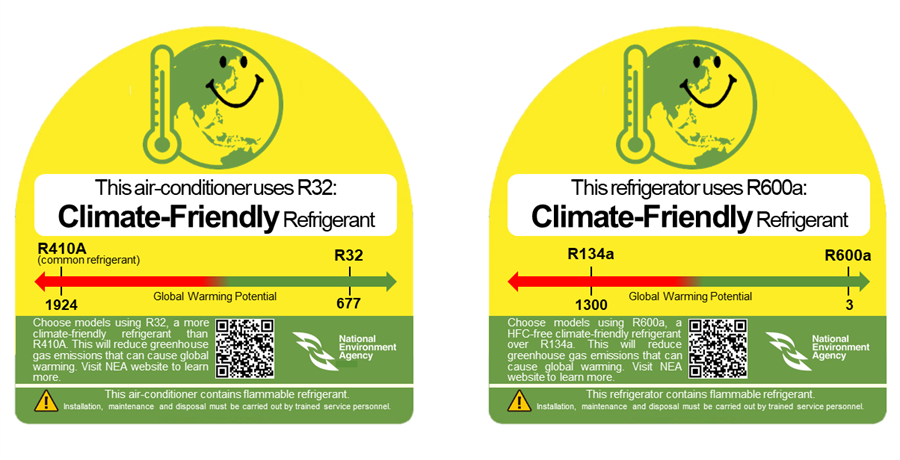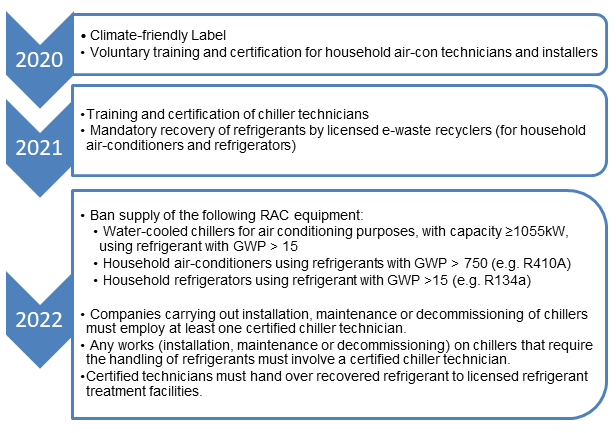Measures include Climate-friendly Label, ban on supply of refrigeration and air-conditioning equipment that use climate-unfriendly refrigerants, training and certification of technicians, and mandatory recovery of refrigerants.
Singapore, 4 March 2020 – Minister for the Environment and Water Resources (MEWR), Mr Masagos Zulkifli, announced today in Parliament a package of mitigation measures to reduce Singapore’s greenhouse gases emissions arising from the use of hydrofluorocarbons (HFCs) in the refrigeration and air-conditioning (RAC) sector.
2 HFCs are commonly used as refrigerants in RAC equipment. When emitted into the environment, HFCs are many times more potent than carbon dioxide in contributing to global warming. The package of measures comprises four key initiatives, aimed at reducing HFC-related greenhouse gas emissions, to be implemented by the National Environment Agency (NEA) in phases from 2020 to 2023.
Climate-friendly Label for household air-conditioners and refrigerators
3 The first key initiative is the Climate-friendly Label for household refrigerators and air-conditioners that use refrigerants with a lower global warming potential (GWP ).
4 The voluntary label for climate-friendly refrigerants will enable consumers to identify and select air-conditioner and refrigerator models that use climate-friendly refrigerants. Major retail stores have expressed their support to display the label in stores from March 2020.

The Voluntary Labels for air-conditioners (left) and refrigerators (right) using climate-friendly refrigerants
Ban on supply of RAC equipment that use high-GWP refrigerants from Q4 2022
5 NEA will also be progressively phasing out RAC equipment that use high-GWP refrigerants. NEA will ban the supply of the following RAC equipment in Singapore from Q4 2022 as there are climate-friendly alternatives:
• Household air-conditioners that use refrigerants with GWP of more than 750;
• Household refrigerators that use refrigerants with GWP of more than 15; and
• Water-cooled chillers that use refrigerants with GWP of more than 15.
6 The public sector will take the lead in switching to climate-friendly RAC equipment. For example, the Home Team Academy has switched to energy-efficient and climate-friendly refrigerant water-cooled chillers, thereby avoiding three kilo-tonnes of CO2 emissions– equivalent to the annual emissions of about 900 cars
7 Some private sector companies have also adopted chillers that use climate-friendly refrigerants. For example, real estate group CapitaLand has installed a climate-friendly refrigerant chilled-water system at the newly redeveloped Funan. This has prevented about five kilo-tonnes of CO2e being emitted - equivalent to the annual emissions of about 1,500 cars. Over time, the energy cost savings from the improved energy efficiency would be more than sufficient to cover the higher initial cost of the equipment.
8 To encourage companies to switch to climate-friendly water-cooled chillers early, NEA has worked together with the Economic Development Board (EDB) and the Building and Construction Authority (BCA) on a new grant to support companies. More details will be announced at a later date.
Training and certification of technicians
9 HFCs can leak into the atmosphere if the refrigerants are improperly handled. To prevent this, NEA is working with the Institute of Technical Education (ITE) and Temasek Polytechnic to introduce training courses for household air-conditioner technicians and chiller technicians respectively.
10 The training and certification scheme aims to raise competencies within the industry on proper handling of refrigerants during installation, maintenance and decommissioning of RAC equipment. The training courses conducted by ITE for household air-conditioner technicians will commence in the second half of 2020, while the courses conducted by Temasek Polytechnic for chiller technicians will commence in 2021.
11 Companies carrying out installation, maintenance and decommissioning of household air-conditioners are encouraged to send their technicians for training and certification. Consumers are also encouraged to request for certified technicians to install and service their air-conditioners, as part of taking climate action at the individual level, to reduce the likelihood of HFC refrigerant emissions into the atmosphere.
12 NEA has consulted the industry on this initiative, and major suppliers and retailers have said that a training scheme would harmonise and uplift industry standards in terms of installation and servicing. The industry is supportive and companies such as Mitsubishi Electric and Toshiba Air-Conditioning have expressed their early support to contribute to train household air-conditioner technicians through equipment sponsorship and funding. Retailers have also expressed interest to engage certified technicians to install air-conditioners after the training courses are rolled out.
13 From 2022 onwards, companies that carry out the installation, maintenance or decommissioning of chillers will be required to employ at least one certified chiller technician.
Mandating recovery, and reclamation or destruction of refrigerants
14 In conjunction with the training and certification of technicians, from July 2021, NEA will be mandating the recovery and reclamation or destruction of spent refrigerants in decommissioned RAC equipment. E-waste recyclers, who take in household air-conditioners and refrigerators for recycling, and certified chiller technicians will be required to recover refrigerants from decommissioned RAC equipment. Refrigerant treatment facilities and e-waste recyclers that handle the reclamation and destruction of spent refrigerants will have to obtain a Toxic Industrial Waste Collector (TIWC) licence from NEA.
15 Recovered refrigerants that are passed to the licensed refrigerant treatment facilities can either be reclaimed and re-introduced into the market to service RAC equipment or destroyed using established destruction technologies to ensure environmentally sound management of the spent refrigerants.
16 The HFC mitigation measures would help reduce Singapore’s HFCs consumption and contribute towards meeting Singapore’s 2030 pledge under the Paris Agreement. The table on the next page shows the timeline and summary of the key initiatives.

[1] Global warming potential (GWP) is a measure of the warming effect of a gas relative to the warming effect of an equivalent mass of CO2, usually over a 100-year time horizon.
[2] The label can be affixed on 1) household air-conditioners that use refrigerants with GWP ≤ 750 (i.e. R32 models), and 2) household refrigerators that use refrigerants with GWP ≤15 (i.e. R600a models). About 10 per cent of registered air-conditioner models in Singapore use refrigerants that are climate-friendly, while majority of the registered refrigerator models in Singapore already use a climate-friendly refrigerant. The list of household air-conditioners and refrigerators can be found on www.go.gov.sg/mels-database
[3] The ban would effectively phase out the sales of household air-conditioner models using the R410A refrigerant (GWP of 1,924), and refrigerator models using the R134a refrigerant (GWP of 1,300). In comparison, climate-friendly alternatives R32 (for air-conditioners) and R600a (for refrigerators) have GWPs of 677 and 3 respectively.
[4] Of capacity equal to or more than 1055kW and used for air-conditioning purposes.
[5] The typical refrigerant used in chillers is R134a, which has a GWP of 1,300. The climate-friendly alternative is R1233zd, which has a GWP of 1.
~~ End ~~
For more information, please contact us at 1800-CALL NEA (1800-2255 632) or submit your enquiries electronically via the Online Feedback Form or myENV mobile application.